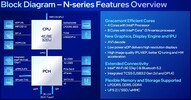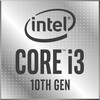Intel Processor N100 vs Intel Core i3-1000NG4 vs Intel Core i3-N305
Intel Processor N100
► remove from comparison
The Intel Processor N100 is an entry-level mobile CPU for thin and light laptops from the Alder Lake-N series. It was announced in early 2023 and offers no performance cores and 4 of the 8 efficient cores (E-cores, Gracemont architecture). The chip does not support HyperThreading and clocks with 1 to 3.4 GHz. The performance of the E-cores should be similar to old Skylake cores (compare to the Core i7-6700HQ). All cores can use up to 6 MB L3-cache.
Performance
The average N100 in our database delivers unimpressive multi-thread benchmark scores that are most similar to those of the Core i3-1115G4. The chip is fast enough for many day-to-day tasks, but not much more than that; the other thing to keep in mind is that of the two N100-toting systems tested by us as of October 2023, both have rather high CPU power limits. The chip will be noticeably slower if limited to just six or seven Watts.
Features
The Alder Lake-N chips only support single channel memory with up to DDR5-4800, DDR4-3200 or LPDDR5-4800. The chip also supports Quick Sync and AV1 decoding (most likely same engine as in Alder Lake). Furthermore, Wi-Fi 6E and Bluetooth 5.2 are partly integrated (but no Thunderbolt). External chips can be connected via PCIe Gen3 x9 (via the PCH).
The integrated graphics adapter is based on the Xe-architecture and offers only 24 of the 32 EUs (Execution Units) operating at only 450 - 750 MHz. Due to the single channel memory, low clock speeds, and low shader count, the gaming performance of the iGPU is very limited.
Power consumption
The N100 has a base power consumption of only 6 W and is therefore suited for fanless cooling. The CPU is built with a further improved 10nm SuperFin process at Intel (called Intel 7).
Intel Core i3-1000NG4
► remove from comparison
The Intel Core i3-1000NG4 is a power efficient dual-core SoC for laptops and Ultrabooks based on the Ice -Lake-Y generation that was announced in Mai 2019 (Computex). It integrates two Sunnycove processor cores (4 threads thanks to HyperThreading) clocked at 1.1 (base) - 3.2 GHz (single and dual core Turbo). According to Intel the Sunnycove cores achieve 18% more IPCs (Instructions per Clock) and therefore the CPU performance should be similar to the higher clocked Amber-Lake-Y CPUs like the Core i5-8200Y (1.3 - 3.9 GHz).
Compared to the normal Core i3-1000G4, the i3-1000NG4 offers a smaller package size (22 x 16.5 versus 26.5 x 18.5 mm).
The biggest improvement for Ice-Lake is the integrated Gen 11 graphics card called Iris Plus Graphics. The Core i7-1030G4 integrates the smaller G4 variant with 48 of the 64 CUs clocked at 300 - 900 MHz. However, in the Y-series the gaming performance will be again depending on the cooling solution and may degrade clearly over time (compared to the Core i5-1035G4 with 15 - 25 Watt e.g.). The faster graphics card is also the main difference to the similar named Core i3-1000G1.
Other improvements for Ice Lake are the AI hardware acceleration and the partial integration of Thunderbolt and Wifi 6 in the chip. The integrated DDR4 memory controller supports modules with up to 3200 MHz (and LPDDDR4 3733).
The Core i3-1000NG4 is produced in the new 10nm process at Intel that should offer a comparable performance to the 7nm process at TSMC. The TDP is specified at 9 Watts and therefore the CPU can be used in thin and light laptops with either a passive or an active cooling system.
Intel Core i3-N305
► remove from comparison
The Intel Core i3-N305 is an entry-level mobile CPU for thin and light laptops from the Alder Lake-N series. It was announced in early 2023 and offers no performance cores and 8 efficient cores (E-cores, Gracemont architecture). The chip does not support HyperThreading and clocks with up to 3.8 GHz. The performance of the E-cores should be similar to old Skylake cores (compare to the Core i7-6700HQ). All cores can use up to 6 MB L3-cache.
Performance
We have not tested a single system built around the N305, as of September 2023. Expect the chip to be 50% to 100% faster than the N95 (4 cores, 4 threads, up to 3.4 GHz).
Your mileage may vary depending on how high the CPU power limits are and how competent the cooling solutuion of your system is.
Features
The Alder Lake-N chips only support single channel memory with up to DDR5-4800, DDR4-3200 or LPDDR5-4800. The chip also supports Quick Sync and AV1 decoding (most likely same engine as in Alder Lake). Furthermore, Wi-Fi 6E and Bluetooth 5.2 are partly integrated (but no Thunderbolt). External chips can be connected via PCIe Gen3 x9 (via the PCH).
The integrated graphics adapter is based on the Xe-architecture and offersall 32 EUs (Execution Units) operating at up to 1.25 GHz. In addition to the single channel memory, the gaming performance is very limited of the iGPU.
Power consumption
The i3 has a base power consumption of 15 W and can be configured down to 9 W. The CPU is built with a further improved 10nm SuperFin process at Intel (called Intel 7).
| Model | Intel Processor N100 | Intel Core i3-1000NG4 | Intel Core i3-N305 | ||||||||||||||||||||||||||||||||||||||||||||||||||||||||||||||||||||||||
| Codename | Alder Lake-N | Ice Lake Y | Alder Lake-N | ||||||||||||||||||||||||||||||||||||||||||||||||||||||||||||||||||||||||
| Series | Intel Alder Lake-N | Intel Ice Lake | Intel Alder Lake-N | ||||||||||||||||||||||||||||||||||||||||||||||||||||||||||||||||||||||||
| Series: Alder Lake-N Alder Lake-N |
|
|
| ||||||||||||||||||||||||||||||||||||||||||||||||||||||||||||||||||||||||
| Clock | 1000 - 3400 MHz | 1100 - 3200 MHz | 1800 - 3800 MHz | ||||||||||||||||||||||||||||||||||||||||||||||||||||||||||||||||||||||||
| L3 Cache | 6 MB | 4 MB | 6 MB | ||||||||||||||||||||||||||||||||||||||||||||||||||||||||||||||||||||||||
| Cores / Threads | 4 / 4 4 x 3.4 GHz Intel Crestmont E-Core | 2 / 4 | 8 / 8 8 x 3.8 GHz Intel Gracemont E-Core | ||||||||||||||||||||||||||||||||||||||||||||||||||||||||||||||||||||||||
| TDP | 6 Watt | 9 Watt | 15 Watt | ||||||||||||||||||||||||||||||||||||||||||||||||||||||||||||||||||||||||
| Technology | 10 nm | 10 nm | 10 nm | ||||||||||||||||||||||||||||||||||||||||||||||||||||||||||||||||||||||||
| max. Temp. | 105 °C | 105 °C | |||||||||||||||||||||||||||||||||||||||||||||||||||||||||||||||||||||||||
| Socket | BGA1264 | BGA1264 | |||||||||||||||||||||||||||||||||||||||||||||||||||||||||||||||||||||||||
| Features | DDR4-3200/DDR5-4800/LPDDR5-4800 RAM (sin. chan.), PCIe 3, GNA, MMX, SSE, SSE2, SSE3, SSSE3, SSE4.1, SSE4.2, AVX, AVX2, BMI2, ABM, FMA, ADX, VMX, SMEP, SMAP, EIST, TM1, TM2, Turbo, SST, AES-NI, RDRAND, RDSEED, SHA | AVX512, DL Boost, Turbo Boost 2.0 | DDR4-3200/DDR5-4800/LPDDR5-4800 RAM (sin. chan.), PCIe 3, GNA, MMX, SSE, SSE2, SSE3, SSSE3, SSE4.1, SSE4.2, AVX, AVX2, BMI2, ABM, FMA, ADX, VMX, SMEP, SMAP, EIST, TM1, TM2, Turbo, SST, AES-NI, RDRAND, RDSEED, SHA | ||||||||||||||||||||||||||||||||||||||||||||||||||||||||||||||||||||||||
| iGPU | Intel UHD Graphics 24EUs (Alder Lake-N) ( - 750 MHz) | Intel Iris Plus Graphics G4 (Ice Lake 48 EU) (300 - 900 MHz) | Intel UHD Graphics 32EUs (Alder Lake) (1000 - 1250 MHz) | ||||||||||||||||||||||||||||||||||||||||||||||||||||||||||||||||||||||||
| Architecture | x86 | x86 | x86 | ||||||||||||||||||||||||||||||||||||||||||||||||||||||||||||||||||||||||
| $128 U.S. | |||||||||||||||||||||||||||||||||||||||||||||||||||||||||||||||||||||||||||
| Announced | |||||||||||||||||||||||||||||||||||||||||||||||||||||||||||||||||||||||||||
| Manufacturer | ark.intel.com | ark.intel.com | |||||||||||||||||||||||||||||||||||||||||||||||||||||||||||||||||||||||||
| L1 Cache | 96 KB | 768 KB | |||||||||||||||||||||||||||||||||||||||||||||||||||||||||||||||||||||||||
| L2 Cache | 1 MB | 4 MB |
Benchmarks
Average Benchmarks Intel Processor N100 → 100% n=31
Average Benchmarks Intel Core i3-1000NG4 → 93% n=31
Average Benchmarks Intel Core i3-N305 → 145% n=31
* Smaller numbers mean a higher performance
1 This benchmark is not used for the average calculation













